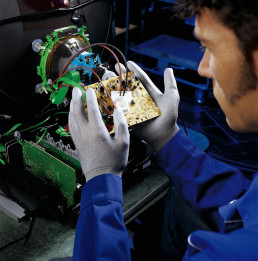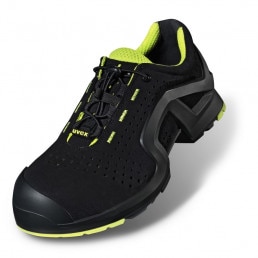There is often confusion between the terms ESD and antistatic, and not just when it comes to safety footwear. While one includes the other, to deduce the same is true in reverse is generally incorrect. Although both terms refer to contact resistance, there are fundamental differences between the two. Confused? Worry not. We are going to shed some light on the matter below.
We previously explored the topic of electrostatic build-up and discharge in A new electrostatic test standard for safety gloves. This is something that many of you will already have experienced first-hand. Safety footwear generally represents the point of connection between the body and the floor. Electrostatic energy and contact resistance are therefore extremely important in this area. However, a distinction must be made between the antistatic properties of shoes and their electrostatic discharge (ESD) capability.
The applicable standard for safety footwear, EN ISO 20345, specifies a variety of requirements, including for electrostatic properties. It defines three areas, based on contact resistance: conductive, antistatic and electrically insulating footwear. For safety shoes to be labelled S1, they must fulfil the basic requirements plus the additional requirements for antistatic. The same applies to all subsequent safety classifications, for both industrial and occupational shoes. Shoes are antistatic if the measured contact resistance is in the range between 100 kiloohm (105 ohm) and 1 gigaohm (109 ohm). According to the standard, if contact resistance falls below this value, they are considered to be conductive, while a higher value means they are electrically insulating.

What are the reasons for this?
The EU standard stipulates that antistatic footwear should be worn to prevent electrostatic build-up and ensure it is discharged effectively. This is essential to eliminate the risk of electric shock from electrical equipment or live parts as well as that posed by sparks igniting flammable substances or vapours.
The aim is therefore to protect those wearing safety shoes (and their colleagues) from dangers related to electrostatic build-up.
So that’s antistatic explained. What does ESD stand for?
Electrostatic build-up and personal safety are not the only important considerations in industry, with controlled discharge also needed to protect components and equipment. Here, another standard comes into play that deals with electrostatic discharge (ESD): EN 61340-5-1 Protection of electronic devices from electrostatic phenomena. The ESD area defined in this standard represents a delimitation of the antistatic range indicated in safety footwear standard EN ISO 20345. The lower threshold of contact resistance is at 100 kiloohm and the upper threshold is at 100 megaohm (1 x 108 ohm). This therefore means that ESD-compliant shoes are always antistatic at the same time, but not all antistatic shoes are ESD compliant. For example, if contact resistance is measured more than 100 megaohm, the shoes are antistatic but do not meet the ESD requirements. However, if the shoe contact resistance is just 1 megaohm, then the footwear is both antistatic and ESD capable.

As ESD relates to meeting the requirements for the product protection standard, the labelling must be separate from the CE marking. Consequently, safety footwear which complies with the standard features an additional yellow ESD symbol. If the shoes do not feature the special ESD symbol but are labelled S1, they are generally antistatic.

Measurement methods and factors influencing results
Testing the antistatic properties of shoes for certification involves a test method under laboratory conditions. Before undergoing the test procedure, the shoe must first be conditioned over a defined length of time (in both dry and moisture-regulated atmospheres). The shoe is then filled with a total mass of 4 kg of stainless steel balls, which are connected to the contact resistance measurement device via a copper cable. The shoe is placed on a copper plate as the external electrode. The test voltage of 100 V DC is applied between the copper plate and the steel balls for one minute while recording the contact resistance of the footwear sample. This must exceed 100 kiloohm, but be less than or equal to 1 gigaohm.
Testing the ESD capability of shoes is slightly more difficult because there are a variety of different measurement procedures for the two standards. For EN 61340-5-1, the contact resistance value is measured for the person-shoe-ground system. This involves an employee standing on a conductive shoe testing electrode while wearing the safety footwear. The resistance is measured when they place their hand on a metal plate. If the measured contact resistance is less than 35 megaohm, the shoes are ESD capable.
The second standard, EN 61340-4-3, determines the contact resistance in a laboratory process. The test object is preconditioned at a predefined temperature and air humidity in a conditioning chamber.
Measurement is carried out once the test object has been conditioned. The shoe is placed on a stainless steel plate as the first electrode and a counter electrode is placed inside the shoe on the insole. Weight of 12.5 kg (+/- 2.5 kg) is then applied. A device measures the contact resistance between the two electrodes. It must be less than 100 megaohm for ESD certification to be granted for the respective climate class.
What factors can influence contact resistance for shoes?
It can sometimes be the case that footwear which has been labelled as ESD capable by the manufacturer then fails the control test carried out by the customer. However, this does not necessarily mean that the shoe is not ESD capable, as there may be a variety of reasons and influences that have affected the result. For example, the temperature of the shoe can impact the discharge capacity. Safety shoes which are left in the car overnight in winter would cool down so considerably that the contact resistance would be higher as a result. Similarly, the duration of wear can be an influencing factor, raising the moisture levels inside the shoes. Moisture generally raises discharge capacity. Other factors include alterations to the outsole or insole and whether contact areas are in any way dirty.

Various different uvex safety footwear models and variants have ESD certification for a wide range of applications. Your sales contact will be happy to provide support and guidance in choosing the perfect footwear model for your needs.
Hey, the article was worth reading, I really like the way you explained it, and thank you for sharing too.
android application development Cochin
Excellent work, I really admire the work of designer, I myself is working with the software development company in Dubai so I understand the importance of good design!
Really great article. Thank you for bringing to a halt my long search topic. I really benefited from your content. Thank you for sharing.
Thank you!
Great work, excellent content as usual. I am Working in a mobile app development company in riyadh
A really comprehensive article. Every detail needed to understand the difference between antistatic and ESD safety is here. Thanks a lot for sharing.